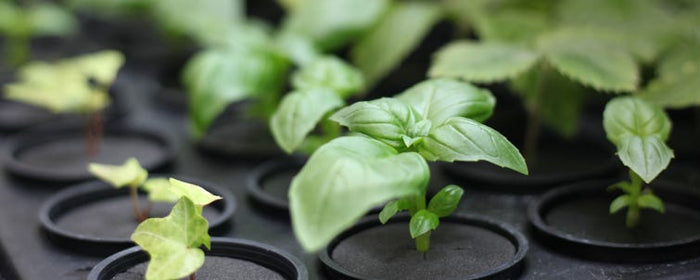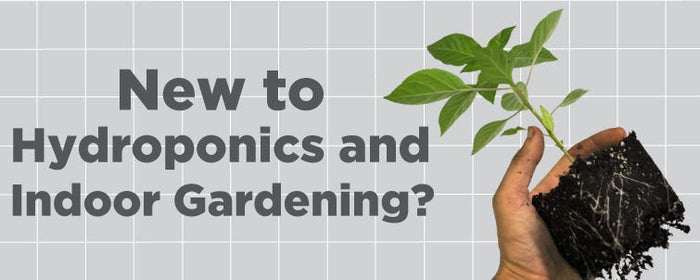
How to Get your Climate Spot On
Controlling your climate doesn’t have to be hard. Here’s everything you need to know.
The Ideal Climate
It depends on what you're growing, but as a rule, you should aim for:
- Temperature: 24oC- 28oC (day/lights on) or 22oC - 23oC (night/lights off)
- Humidity (RH): 70 – 85% (propagation), 65 – 75% (veg), 45 – 65% (flowering)
- CO2 level: 1000ppm - 1200ppm for up to 40% faster growth
Air Exchange Vs. Closed Loop Rooms
There's no right or wrong way of doing it - it just depends how much control you want, and what your budget is.
Air Exchange Set Up
To keep your temperature, humidity and CO2 levels under control, you extract stale air and draw fresh air in.
You’ll probably need a heater in winter. In summer, you'll need to extract more air, but be warned, your grow room can never be cooler than the air you're drawing in, if you rely solely on air exchange.
| Pros |
|---|
|
| Cons |
|---|
|
The equipment you need depends on your set up.
Standard set ups largely rely on air exchange. For this, in a small room, all you strictly need is an extraction system and heater.
| Must |
|---|
|
| Optional |
|---|
|
Closed Loop Set Up
Closed loop growing spaces are almost completely sealed off.
Hardly any air enters, hardly any air leaves. Rather than exchanging air, you constantly treat the air that’s already in your grow room.
Why bother? You get complete climate control (temperature, CO2 levels, humidity, etc.) while keeping pests and diseases out!
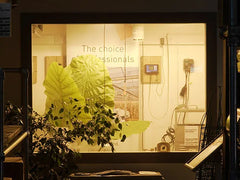
| Pros |
|---|
|
| Cons |
|---|
|
You don’t need an air exchange system. Instead, you treat the air that’s already in your grow room. As a bare minimum, you need to cool, heat, add CO2 and remove humidity.
| Must |
|---|
|
| Optional |
|---|
|
Extraction
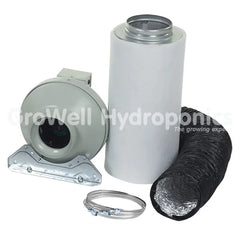
What you need will depend on:
- Your lights
- The size of your grow space
- The time of year (more air needs to be extracted during summer months)
As a general rule, the more lights you have, the better your air exchange system needs to be.
If in doubt, it's always better to overspec than underspec.
Extractor Fans
Extractor fans draw air out of your grow room. You need one that extracts enough air.
To work out how much air it needs to extract:
Step 1
Multiply your tent's L x W x H
The answer is how much space is covered by your grow lights
| example: |
|---|
|
In an XL BAY6 Tent: 1.2m x 1.2m x 2m = 2.88m3 2.88m3 is the total area covered by your lights. |
Step 2
Multiply this by 60
That'll tell you how much air to extract every hour.
| example: |
|---|
|
In an XL BAY6 Tent: 2.88m3 x 60 = 172.8m3 A 100mm (4"") RVK100 would do the trick! |
Step 3 (optional)
To be really precise, you can:
- Add 20% for a warm attic
- Add 20% if using a carbon filter
- Minus 15% in a cool basement
- Add 20% for long ducting
- Minus 25 - 30% for air cooled lighting
Intake Fans
If you’re only extracting a small amount of air, you can get away with using vents to passively draw air in.
If you do need an intake fan, make sure you draw in less air than you extract. Otherwise, you can end up overfilling your tent, and unfiltered air will start seeping out.
Method 1 (easiest)
Use an intake fan that’s 25 - 30% less powerful than your extractor fan and run them at the same speed.
Method 2
If both fans are the same size (not recommended), run your intake fan at a slightly lower speed than your extractor fan.
Top Tips
- South facing rooms are hotter than north facing rooms, so you might need a bigger extractor fan.
- Remember that your fans should be placed at opposite ends of your grow room so you don’t extract air that has just been drawn in
- If you’re torn between two size fans, buy the bigger one and run it at a slower speed
EC vs. AC Fans
EC fans cost more to buy, but are so much cheaper to run that you make back the cost of the fan after just a year.
After 5 years, you'll have saved up to £1,380! Fact. Really, see the number crunching we did.
Fan Controllers
Unless you want your fans to run at full power all the time (nobody wants that), you need a fan speed controller. They speed fans up or slow them down to get your temperature bang on.
To make sure enough air is extracted to maintain your CO2 level and humidity, you can set your minimum fan speed.
The controller you need depends on your fan:
- AC fans need an AC controller
- EC fans need the same brand EC controller
Air Conditioning
There are a couple of kinds to choose from. Before buying, give us a call, so we can help you choose and install the right unit.
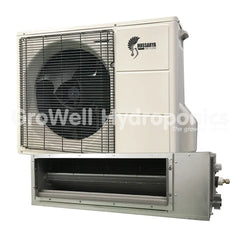
Split Air Cooled Systems:
- Indoor and outdoor unit
- No water needed – can be a huge cost saver
Hussarya air conditioning units are the ones we recommend.
| Silence | Breeze | Storm | Typhoon | Hurricane | |
|
No of 600W lights |
4 | 8 | 12 | 18 | 24 |
|
No of 1000W lights |
3 | 5 | 7 | 10 |
14 |
Water Cooled Systems:
- Water cooled system – they’re basically the opposite of a radiator
- Indoor unit only – great if you’ve not got space for an outdoor unit
We recommend using an Opticlimate water cooled unit. They've been run, tested and adjusted for plug & play installation.
Which Is Cheaper To Run?
The real question is: How you pay your bills?
If your water bill is fixed, the water cooled system is a good option. If you’re on a water meter, a split system is better.
See Them In Action!
Working closed loop rooms are set up in most shops. Call your local shop to check before visiting.
Odour Control
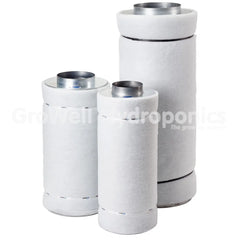
To remove odours, at the very least you need a carbon filter. And not just any carbon filter - one that’s deep enough for all air passing through it to be in to be in contact with the carbon for 0.1 – 0.2 seconds.
The trick is to match your carbon filter to yout extractor fan. To take the headache out of this, you can buy a complete extraction kit.
Don’t forget to change your carbon filter every 6 – 18 months, depending on the brand and type of filter.
If a carbon filter alone isn't removing all odours, there are other steps you can take. Read 'Stop Odours Escaping! Eliminate Grow Room Smells.'
Choosing A Heater
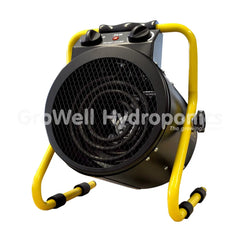
Most air conditioning systems will also heat your grow room. If yours does, you won’t need a heater.
If you do need a heater, choose one with an internal thermostat.
The heater will only warm when it needs to – all you need to do is set your target temperature.
There’s no worry of over heating or under heating…you don’t need to faff around with a timer. Best of all, your grow room will always be close to your target temperature.
A KlimaHeat Electric Grow Room Heater promises to keep your grow room within 2°C of your target!
CO2 Equipment
For up to 40% more growth, aim for a CO2 level of around 800ppm (veg) or 1200ppm (flowering).
If you're really serious about CO2, you should really use an LPG generator or release Bottled CO2 Gas in a closed loop room.
But you can enrich all grow rooms on a low budget, using MyCO2 Bags or TNB The Enhancer Cannisters.
If you're looking at adding CO2, give 'CO2 Generation Tutorial' a read. Here's a quick overview of the 3 main methods:
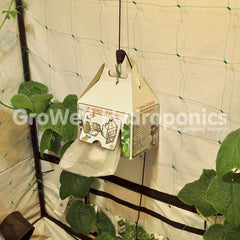
ExHale Bags Or TNB Bottles
Both ExHale Bags and TNB The Enhancer Canisters only start releasing CO2 when activated by you. This means no CO2 is lost in transport or storage.
Just make sure you have enough bottles or bags to cover your growing area:
- MyCO2 Grow: 1.2m x 1.2m x 2m area, 800ppm for 180 days
- MyCO2 Bloom: 1.2m x 1.2m x 2m area, 1200ppm, 60 days
- TNB The Enhancer: 3.65m x 3.65m area, 1200ppm for 2 weeks
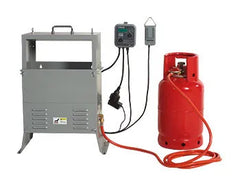
Use An LPG CO2 Generator
You produce CO2 by burning Liquid Propane Gas. Humidity is released as a byproduct, which is great in veg. You will need:
- Propane cannister (red / orange)
- LPG Generator (e.g. Pro-Leaf or AutoPilot)
- UK Propane Regulator (Low Pressure)
- CO2 controller (with inbuilt sensor / analyser)
- Pipe cutters
- Leak detection fluid
- Hose clamp / gas hose clips
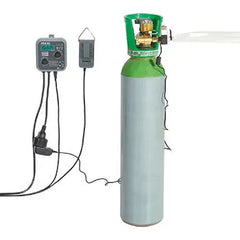
Use A Bottled Gas Generator
With this method, CO2 vapour is released as and when you need it. You will need:
- Bottles of CO2 gas (food grade – like pubs use)
- CO2 Dispersion tubing
- CO2 Regulator (with Solenoid valve)
- CO2 Controller (with inbuilt sensor/analyser)
- Power lead / cable fitted with plug
- 2-3 pin plug adaptor
If your controller doesn't have an inbuilt sensor or analyser, you can buy them separately.
Air Circulation Fans
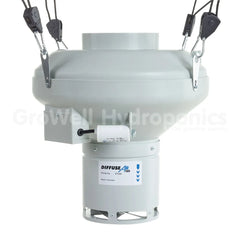
Air circulation fans make sure that heat, humidity and CO2 are evenly distributed across your growing area.
Make sure you don’t point them directly at plants, this can cause too much water loss from the leaves, leading to windburn.
You can't go wrong with a DiffuseAir. They were designed to prevent harsh air streams that cause windburn. Unlike pedestal fans, they don't take up any floor space.
For spot cooling in areas that are tough to reach, use supplemental clip on fans. You can get them for as little as £9.95 each.
Humidifiers And Dehumifiers
As plants transpire, they naturally release moisture into the surrounding air.
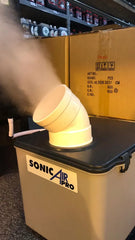
If You Have An Air Exchange System
Your air exchange system draws humid air out, so you may not need to dehumidify.
However, if you do notice your humidity creeping up too high, check how much water plants are using in 24 hours, then dehumidify by this much. You can tell how much water has been used by checking your tank.
You will likely need to humidify at some point. Especially during veg or times when your temperature is a problem.
If You Have A Closed Loop Set Up
You won’t be removing any of the moisture created by your plants.
This means two things:
- It’s unlikely that you will need a humidifier once the plants have formed enough foliage.
- You will definitely need a dehumidifier (or an air con system that deals with humidity)
It doesn't have to cost a lot to manage your humidity. You can get a basic humidifier for as little as £32.99 and a humidity meter for only £9.99.
However, for best results, we recommend using a G.A.S SonicAir Pro Humidifier, which will let you control your VPD.
As for your dehumidifier, a Dessicant Dehumidifier is fine, but if you have a closed loop room or large set up you may need something like a Quest Dehumidifier
ALWAYS Use An RO Filter With A Humidifier
If you don’t, mineral deposits will ruin your reflectors and reduce output from lamps. They’ll also clog up your carbon filters causing less extraction!
As a result, your equipment will need replacing more often. Worse yet, the resulting loss in light will severely impact plant growth. Find out more here.

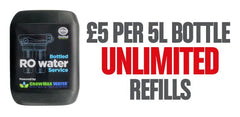
| Pros |
|---|
|
| Cons |
|---|
|
The equipment you need depends on your set up.
Standard set ups largely rely on air exchange. For this, in a small room, all you strictly need is an extraction system and heater.
| Must |
|---|
|
| Optional |
|---|
|
Closed Loop Set Up
Closed loop growing spaces are almost completely sealed off.
Hardly any air enters, hardly any air leaves. Rather than exchanging air, you constantly treat the air that’s already in your grow room.
Why bother? You get complete climate control (temperature, CO2 levels, humidity, etc.) while keeping pests and diseases out!

Closed Loop Room in Dudley
| Pros |
|---|
|
| Cons |
|---|
|
You don’t need an air exchange system. Instead, you treat the air that’s already in your grow room. As a bare minimum, you need to cool, heat, add CO2 and remove humidity.
| Must |
|---|
|
| Optional |
|---|
|
Extraction

What you need will depend on:
- Your lights
- The size of your grow space
- The time of year (more air needs to be extracted during summer months)
As a general rule, the more lights you have, the better your air exchange system needs to be.
If in doubt, it's always better to over-spec than under-spec.
Extractor Fans
Extractor fans draw air out of your grow room. You need one that extracts enough air.
To work out how much air it needs to extract:
Step 1
Multiply your tent's L x W x H
The answer is how much space is covered by your grow lights
| example: |
|---|
|
In an XL BAY6 Tent: 1.2m x 1.2m x 2m = 2.88m3 2.88m3 is the total area covered by your lights. |
Step 2
Multiply this by 60
That'll tell you how much air to extract every hour.
| example: |
|---|
|
In an XL BAY6 Tent: 2.88m3 x 60 = 172.8m3 A 100mm (4"") RVK100 would do the trick! |
Step 3 (optional)
To be really precise, you can:
- Add 20% for a warm attic
- Add 20% if using a carbon filter
- Minus 15% in a cool basement
- Add 20% for long ducting
- Minus 25 - 30% for air cooled lighting
Intake Fans
If you’re only extracting a small amount of air, you can get away with using vents to passively draw air in.
If you do need an intake fan, make sure you draw in less air than you extract. Otherwise, you can end up overfilling your tent, and unfiltered air will start seeping out.
Method 1 (easiest)
Use an intake fan that’s 25 - 30% less powerful than your extractor fan and run them at the same speed.
Method 2
If both fans are the same size (not recommended), run your intake fan at a slightly lower speed than your extractor fan.
Top Tips
- South facing rooms are hotter than north facing rooms, so you might need a bigger extractor fan.
- Remember that your fans should be placed at opposite ends of your grow room so you don’t extract air that has just been drawn in
- If you’re torn between two size fans, buy the bigger one and run it at a slower speed
EC vs. AC Fans
EC fans cost more to buy, but are so much cheaper to run that you make back the cost of the fan after just a year.
After 5 years, you'll have saved up to £1,380! Fact. Really, see the number crunching we did.
Fan Controllers
Unless you want your fans to run at full power all the time (nobody wants that), you need a fan speed controller. They speed fans up or slow them down to get your temperature bang on.
To make sure enough air is extracted to maintain your CO2 level and humidity, you can set your minimum fan speed.
The controller you need depends on your fan:
- AC fans need an AC controller
- EC fans need the same brand EC controller
Air Conditioning
There are a couple of kinds to choose from. Before buying, give us a call, so we can help you choose and install the right unit.

Split Air Cooled Systems:
- Indoor and outdoor unit
- No water needed – can be a huge cost saver
Hussarya air conditioning units are the ones we recommend.
Water Cooled Systems:
- Water cooled system – they’re basically the opposite of a radiator
- Indoor unit only – great if you’ve not got space for an outdoor unit
We recommend using a Commissioned Opticlimate water cooled unit. They've been run, tested and adjusted for plug & play installation.
Which Is Cheaper To Run?
The real question is: How you pay your bills?
If your water bill is fixed, the water cooled system is a good option. If you’re on a water meter, a split system is better.
See Them In Action!
Working closed loop rooms are set up in most shops. Call your local shop to check before visiting.
Odour Control

To remove odours, at the very least you need a carbon filter. And not just any carbon filter - one that’s deep enough for all air passing through it to be in to be in contact with the carbon for 0.1 – 0.2 seconds.
The trick is to match your carbon filter to yout extractor fan. To take the headache out of this, you can buy a complete extraction kit.
Don’t forget to change your carbon filter every 6 – 18 months, depending on the brand and type of filter.
If a carbon filter alone isn't removing all odours, there are other steps you can take. Read 'Stop Odours Escaping! Eliminate Grow Room Smells.'
Choosing A Heater

Most air conditioning systems will also heat your grow room. If yours does, you won’t need a heater.
If you do need a heater, choose one with an internal thermostat.
The heater will only warm when it needs to – all you need to do is set your target temperature.
There’s no worry of over heating or under heating…you don’t need to faff around with a timer. Best of all, your grow room will always be close to your target temperature.
A KlimaHeat Electric Grow Room Heater promises to keep your grow room within 2°C of your target!
CO2 Equipment
For up to 40% more growth, aim for a CO2 level of around 800ppm (veg) or 1200ppm (flowering).
If you're really serious about CO2, you should really use an LPG generator or release Bottled CO2 Gas in a closed loop room.
But you can enrich all grow rooms on a low budget, using MyCO2 Bags or TNB The Enhancer Cannisters.
If you're looking at adding CO2, give 'CO2 Generation Tutorial' a read. Here's a quick overview of the 3 main methods:

ExHale Bags Or TNB Bottles
Both ExHale Bags and TNB The Enhancer Canisters only start releasing CO2 when activated by you. This means no CO2 is lost in transport or storage.
Just make sure you have enough bottles or bags to cover your growing area:
- MyCO2 Grow: 1.2m x 1.2m x 2m area, 800ppm for 180 days
- MyCO2 Bloom: 1.2m x 1.2m x 2m area, 1200ppm, 60 days
- TNB The Enhancer: 3.65m x 3.65m area, 1200ppm for 2 weeks

Use An LPG CO2 Generator
You produce CO2 by burning Liquid Propane Gas. Humidity is released as a byproduct, which is great in veg. You will need:
- Propane cannister (red / orange)
- LPG Generator (e.g. Pro-Leaf or AutoPilot)
- UK Propane Regulator (Low Pressure)
- CO2 controller (with inbuilt sensor / analyser)
- Pipe cutters
- Leak detection fluid
- Hose clamp / gas hose clips

Use A Bottled Gas Generator
With this method, CO2 vapour is released as and when you need it. You will need:
- Bottles of CO2 gas (food grade – like pubs use)
- CO2 Dispersion tubing
- CO2 Regulator (with Solenoid valve)
- CO2 Controller (with inbuilt sensor/analyser)
- Power lead / cable fitted with plug
- 2-3 pin plug adaptor
If your controller doesn't have an inbuilt sensor or analyser, you can buy them separately.
Air Circulation Fans

Air circulation fans make sure that heat, humidity and CO2 are evenly distributed across your growing area.
Make sure you don’t point them directly at plants, this can cause too much water loss from the leaves, leading to windburn.
You can't go wrong with a DiffuseAir. They were designed to prevent harsh air streams that cause windburn. Unlike pedestal fans, they don't take up any floor space.
For spot cooling in areas that are tough to reach, use supplemental clip on fans. You can get them for as little as £9.95 each.
Humidifiers And Dehumifiers
As plants transpire, they naturally release moisture into the surrounding air.

If You Have An Air Exchange System
Your air exchange system draws humid air out, so you may not need to dehumidify.
However, if you do notice your humidity creeping up too high, check how much water plants are using in 24 hours, then dehumidify by this much. You can tell how much water has been used by checking your tank.
You will likely need to humidify at some point. Especially during veg or times when your temperature is a problem.
If You Have A Closed Loop Set Up
You won’t be removing any of the moisture created by your plants.
This means two things:
- It’s unlikely that you will need a humidifier once the plants have formed enough foliage.
- You will definitely need a dehumidifier (or an air con system that deals with humidity)
It doesn't have to cost a lot to manage your humidity. You can get a basic humidifier for as little as £32.99 and a humidity meter for only £9.99.
However, for best results, we recommend using a G.A.S SonicAir Pro Humidifier, which will let you control your VPD.
As for your dehumidifier, a Dessicant Dehumidifier is fine, but if you have a closed loop room or large set up you may need something like a Quest Dehumidifier
ALWAYS Use An RO Filter With A Humidifier
If you don’t, mineral deposits will ruin your reflectors and reduce output from lamps. They’ll also clog up your carbon filters causing less extraction!
As a result, your equipment will need replacing more often. Worse yet, the resulting loss in light will severely impact plant growth. Find out more here.


| Pros |
|---|
|
| Cons |
|---|
|
The equipment you need depends on your set up.
Standard set ups largely rely on air exchange. For this, in a small room, all you strictly need is an extraction system and heater.
| Must |
|---|
|
| Optional |
|---|
|
Closed Loop Set Up
Closed loop growing spaces are almost completely sealed off.
Hardly any air enters, hardly any air leaves. Rather than exchanging air, you constantly treat the air that’s already in your grow room.
Why bother? You get complete climate control (temperature, CO2 levels, humidity, etc.) while keeping pests and diseases out!

Closed Loop Room in Dudley
| Pros |
|---|
|
| Cons |
|---|
|
You don’t need an air exchange system. Instead, you treat the air that’s already in your grow room. As a bare minimum, you need to cool, heat, add CO2 and remove humidity.
| Must |
|---|
|
| Optional |
|---|
|
Extraction

What you need will depend on:
- Your lights
- The size of your grow space
- The time of year (more air needs to be extracted during summer months)
As a general rule, the more lights you have, the better your air exchange system needs to be.
If in doubt, it's always better to over-spec than under-spec.
Extractor Fans
Extractor fans draw air out of your grow room. You need one that extracts enough air.
To work out how much air it needs to extract:
Step 1
Multiply your tent's L x W x H
The answer is how much space is covered by your grow lights
| example: |
|---|
|
In an XL BAY6 Tent: 1.2m x 1.2m x 2m = 2.88m3 2.88m3 is the total area covered by your lights. |
Step 2
Multiply this by 60
That'll tell you how much air to extract every hour.
| example: |
|---|
|
In an XL BAY6 Tent: 2.88m3 x 60 = 172.8m3 A 100mm (4"") RVK100 would do the trick! |
Step 3 (optional)
To be really precise, you can:
- Add 20% for a warm attic
- Add 20% if using a carbon filter
- Minus 15% in a cool basement
- Add 20% for long ducting
- Minus 25 - 30% for air cooled lighting
Intake Fans
If you’re only extracting a small amount of air, you can get away with using vents to passively draw air in.
If you do need an intake fan, make sure you draw in less air than you extract. Otherwise, you can end up overfilling your tent, and unfiltered air will start seeping out.
Method 1 (easiest)
Use an intake fan that’s 25 - 30% less powerful than your extractor fan and run them at the same speed.
Method 2
If both fans are the same size (not recommended), run your intake fan at a slightly lower speed than your extractor fan.
Top Tips
- South facing rooms are hotter than north facing rooms, so you might need a bigger extractor fan.
- Remember that your fans should be placed at opposite ends of your grow room so you don’t extract air that has just been drawn in
- If you’re torn between two size fans, buy the bigger one and run it at a slower speed
EC vs. AC Fans
EC fans cost more to buy, but are so much cheaper to run that you make back the cost of the fan after just a year.
After 5 years, you'll have saved up to £1,380! Fact. Really, see the number crunching we did.
Fan Controllers
Unless you want your fans to run at full power all the time (nobody wants that), you need a fan speed controller. They speed fans up or slow them down to get your temperature bang on.
To make sure enough air is extracted to maintain your CO2 level and humidity, you can set your minimum fan speed.
The controller you need depends on your fan:
- AC fans need an AC controller
- EC fans need the same brand EC controller
Air Conditioning
There are a couple of kinds to choose from. Before buying, give us a call, so we can help you choose and install the right unit.

Split Air Cooled Systems:
- Indoor and outdoor unit
- No water needed – can be a huge cost saver
Hussarya air conditioning units are the ones we recommend.
Water Cooled Systems:
- Water cooled system – they’re basically the opposite of a radiator
- Indoor unit only – great if you’ve not got space for an outdoor unit
We recommend using a Commissioned Opticlimate water cooled unit. They've been run, tested and adjusted for plug & play installation.
Which Is Cheaper To Run?
The real question is: How you pay your bills?
If your water bill is fixed, the water cooled system is a good option. If you’re on a water meter, a split system is better.
See Them In Action!
Working closed loop rooms are set up in most shops. Call your local shop to check before visiting.
Odour Control

To remove odours, at the very least you need a carbon filter. And not just any carbon filter - one that’s deep enough for all air passing through it to be in to be in contact with the carbon for 0.1 – 0.2 seconds.
The trick is to match your carbon filter to yout extractor fan. To take the headache out of this, you can buy a complete extraction kit.
Don’t forget to change your carbon filter every 6 – 18 months, depending on the brand and type of filter.
If a carbon filter alone isn't removing all odours, there are other steps you can take. Read 'Stop Odours Escaping! Eliminate Grow Room Smells.'
Choosing A Heater

Most air conditioning systems will also heat your grow room. If yours does, you won’t need a heater.
If you do need a heater, choose one with an internal thermostat.
The heater will only warm when it needs to – all you need to do is set your target temperature.
There’s no worry of over heating or under heating…you don’t need to faff around with a timer. Best of all, your grow room will always be close to your target temperature.
A KlimaHeat Electric Grow Room Heater promises to keep your grow room within 2°C of your target!
CO2 Equipment
For up to 40% more growth, aim for a CO2 level of around 800ppm (veg) or 1200ppm (flowering).
If you're really serious about CO2, you should really use an LPG generator or release Bottled CO2 Gas in a closed loop room.
But you can enrich all grow rooms on a low budget, using MyCO2 Bags or TNB The Enhancer Cannisters.
If you're looking at adding CO2, give 'CO2 Generation Tutorial' a read. Here's a quick overview of the 3 main methods:

ExHale Bags Or TNB Bottles
Both ExHale Bags and TNB The Enhancer Canisters only start releasing CO2 when activated by you. This means no CO2 is lost in transport or storage.
Just make sure you have enough bottles or bags to cover your growing area:
- MyCO2 Grow: 1.2m x 1.2m x 2m area, 800ppm for 180 days
- MyCO2 Bloom: 1.2m x 1.2m x 2m area, 1200ppm, 60 days
- TNB The Enhancer: 3.65m x 3.65m area, 1200ppm for 2 weeks

Use An LPG CO2 Generator
You produce CO2 by burning Liquid Propane Gas. Humidity is released as a byproduct, which is great in veg. You will need:
- Propane cannister (red / orange)
- LPG Generator (e.g. Pro-Leaf or AutoPilot)
- UK Propane Regulator (Low Pressure)
- CO2 controller (with inbuilt sensor / analyser)
- Pipe cutters
- Leak detection fluid
- Hose clamp / gas hose clips

Use A Bottled Gas Generator
With this method, CO2 vapour is released as and when you need it. You will need:
- Bottles of CO2 gas (food grade – like pubs use)
- CO2 Dispersion tubing
- CO2 Regulator (with Solenoid valve)
- CO2 Controller (with inbuilt sensor/analyser)
- Power lead / cable fitted with plug
- 2-3 pin plug adaptor
If your controller doesn't have an inbuilt sensor or analyser, you can buy them separately.
Air Circulation Fans

Air circulation fans make sure that heat, humidity and CO2 are evenly distributed across your growing area.
Make sure you don’t point them directly at plants, this can cause too much water loss from the leaves, leading to windburn.
You can't go wrong with a DiffuseAir. They were designed to prevent harsh air streams that cause windburn. Unlike pedestal fans, they don't take up any floor space.
For spot cooling in areas that are tough to reach, use supplemental clip on fans. You can get them for as little as £9.95 each.
Humidifiers And Dehumifiers
As plants transpire, they naturally release moisture into the surrounding air.

If You Have An Air Exchange System
Your air exchange system draws humid air out, so you may not need to dehumidify.
However, if you do notice your humidity creeping up too high, check how much water plants are using in 24 hours, then dehumidify by this much. You can tell how much water has been used by checking your tank.
You will likely need to humidify at some point. Especially during veg or times when your temperature is a problem.
If You Have A Closed Loop Set Up
You won’t be removing any of the moisture created by your plants.
This means two things:
- It’s unlikely that you will need a humidifier once the plants have formed enough foliage.
- You will definitely need a dehumidifier (or an air con system that deals with humidity)
It doesn't have to cost a lot to manage your humidity. You can get a basic humidifier for as little as £32.99 and a humidity meter for only £9.99.
However, for best results, we recommend using a G.A.S SonicAir Pro Humidifier, which will let you control your VPD.
As for your dehumidifier, a Dessicant Dehumidifier is fine, but if you have a closed loop room or large set up you may need something like a Quest Dehumidifier
ALWAYS Use An RO Filter With A Humidifier
If you don’t, mineral deposits will ruin your reflectors and reduce output from lamps. They’ll also clog up your carbon filters causing less extraction!
As a result, your equipment will need replacing more often. Worse yet, the resulting loss in light will severely impact plant growth. Find out more here.




